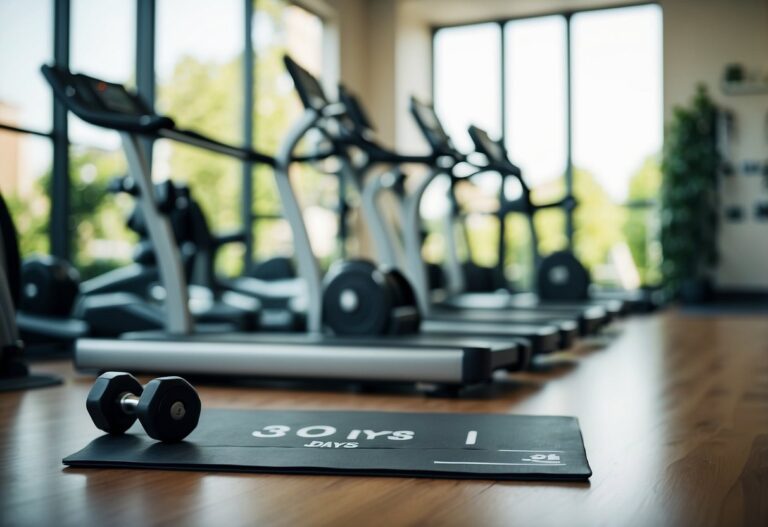Interval workouts can be a game-changer for your fitness routine, whether you’re a seasoned athlete or just getting started. These workouts, characterised by alternating periods of high and low intensity, are designed to boost both speed and endurance. They offer a time-efficient way to improve your cardiovascular health and overall performance.

In this article, you’ll learn practical tips to make your interval workouts effective and enjoyable. From pacing strategies to recovery techniques, we’ll cover the essentials you need to enhance your training sessions. Adopting these insights can help you reach your fitness goals more efficiently, providing both novice and experienced runners valuable tools to optimise their performance.
Warm-up: Light Jog

A light jog is a great way to ease into your interval workout. Start by jogging at a comfortable pace for about 5-10 minutes. This helps increase your heart rate and gets blood flowing to your muscles.
Keep your pace easy and relaxed. It’s not about speed, but about preparing your body for the workout ahead. Pay attention to your breathing and form.
You might find that your mind also benefits from this gentle start. Use this time to focus and set your intentions for the session. Think about what you want to achieve with your intervals today.
Incorporating a light jog into your warm-up routine helps reduce the risk of injury. It also makes your overall workout more effective by loosening up your muscles and joints. So, lace up your shoes and get moving!
Interval 1: Fast Sprints
Fast sprints are great for building speed and endurance.
Start with a dynamic warm-up for about 15 minutes. This prepares your muscles for the intense effort.
Next, sprint at maximum speed for 30 seconds. Push yourself, but stay in control.
Recover by jogging or walking for 1-5 minutes. This rest helps your muscles recover before the next sprint.
Repeat this pattern 6-10 times. Adjust based on your fitness level. Aim for quality, not just quantity.
Make sure to cool down with light jogging and stretching. This helps prevent injuries and aids recovery.
Interval 2: Hill Climbs

Hill climbs are great for building leg strength and endurance.
Start with 4-6 short hill sprints of 10-30 seconds, with 1-2 minutes of easy recovery running. This routine helps improve your running economy and is easy to manage.
For cycling, try 3 intervals of 1 minute at around 95% effort, or 7 intervals of 4-5 minutes on longer hills for variety.
Remember, mixing up your hill distances and gradients keeps your training effective. Try different hills each week to challenge yourself and keep your workouts exciting.
Feeling the burn on those climbs? That’s your muscles getting stronger!
Cool Down: Gentle Walk
After finishing your interval workout, it’s important to transition your body to a resting state. A gentle walk is a perfect way to do this.
Start by walking at a slow pace. This allows your heart rate to gradually return to normal. You’ll feel your breathing become steadier, and it’s a nice way to ease out of your workout.
Aim for 3 to 5 minutes of walking. This short period helps to flush out any lactic acid that may have built up in your muscles, reducing the risk of soreness the next day.
Try to enjoy this time. Reflect on the workout you just completed and feel proud of your effort.
Interval 3: High Knees
High knees are a fantastic way to boost your heart rate and improve cardio endurance. Start by standing with your feet hip-width apart. Then, lift one knee as high as you can towards your chest. Alternate legs quickly, aiming to get into a rhythm.
To add intensity, use your arms. Swing them in time with your steps, reaching up and down as your legs move. This engages your upper body as well.
Remember to maintain an upright posture. Keep your core tight to support your spine. Focus on landing softly to avoid stress on your knees.
Rest: Deep Breaths

Taking deep breaths during rest periods can help you recover between intervals. Focus on inhaling through your nose and exhaling slowly through your mouth. This helps calm your body and mind.
When you finish a tough interval, take a moment to stand still or walk. Use this time to take deep, controlled breaths.
Breathing techniques play a key role in workout recovery. For instance, using a method where you breathe through your nose can help you maintain the right exercise intensity. Give it a try next time you’re struggling to catch your breath.
Deep breathing isn’t just about recovery. It can also boost your workout. When you’re struggling, a few deep breaths can help you reset and prepare for the next push.
Interval 4: Burpees

Burpees are a fantastic full-body exercise. Start in a standing position, then squat down and jump your feet back into a plank. This simple move engages your core and builds strength.
For added intensity, perform a push-up while in the plank position. Jump your feet back to your hands, stand up, and finish with a jump.
Tabata burpees are an excellent challenge. Perform burpees for 20 seconds at max effort, then rest for 10 seconds. Repeat this cycle for four minutes. This high-intensity interval will push your limits and boost your endurance.
Burpees can be done anywhere, making them ideal for any workout routine.
Hydration: Drink Water

Staying hydrated is crucial during your interval workouts. Drink water regularly to maintain energy and performance.
Before you start, drink about 16-24 ounces of water. This helps you start hydrated and ready to tackle your exercise.
During your workout, aim to drink 16-32 ounces every 30-60 minutes. Adjust based on the intensity and your comfort level.
After you finish, drink water within 30 minutes. This helps kickstart your recovery. Remember, even when you’re not working out, keep sipping water throughout the day.
Carrying a reusable water bottle can remind you to drink regularly. This simple habit makes a big difference.
Interval 5: Jump Squats
Jump squats are a fantastic addition to your HIIT routine. They can get your heart rate up quickly and work multiple muscle groups.
Start by standing with your feet shoulder-width apart. Lower yourself into a squat position, pushing your hips back and keeping your chest up.
Explosively jump upwards, reaching for the sky with your arms. Land softly, bending your knees to absorb the impact, then go back into the squat position.
Jump squats might be tough, but they are highly effective. They combine strength and explosive power, which is great for improving your fitness.
Remember to warm up before starting to keep yourself safe and injury-free.
Interval 6: Butt Kicks
Butt kicks are a fantastic way to build strength and improve form. Stand tall with your feet hip-width apart. Start by bringing your left heel up to your glutes. Try to make contact with your buttocks. This depends on your flexibility.
Move rapidly, alternating each leg. This move mimics the running motion. It’s excellent for warming up or adding variety to your interval training.
Focus on keeping a steady pace. Try these in your next workout for better dynamics. For a detailed guide, check out the instructions on how to do butt kicks with proper form.
Understanding Interval Workouts
Interval workouts are a fantastic way to improve your running efficiency and overall endurance. By alternating between intense exercise and recovery, you challenge different muscle groups and boost your cardiovascular health.
What Are Interval Workouts?
Interval workouts involve alternating short bursts of high-intensity running with periods of lower-intensity recovery or rest. For example, you might sprint for 30 seconds, then jog or walk for 1 minute. Repeat this cycle multiple times. This method ensures you push your body hard, but also give it a chance to recover.
One popular example is to run at a moderate pace for 2 minutes and then sprint for 1 minute. You can adjust the duration and intensity based on your fitness level. Adapting your speed according to terrain, like running harder up hills, can also spice up your routine.
Benefits of Interval Workouts
Interval workouts offer many benefits for runners. First, they help to increase your speed and endurance. By pushing your limits during sprints, your body adapts to higher speeds over time. This means you’ll run faster even during your steady runs.
Another major benefit is that these workouts improve your cardiovascular health. Alternating between high-intensity and recovery phases forces your heart to pump blood more efficiently.
Lastly, interval training can also be a great calorie burner. The intense bursts of activity boost your metabolism, meaning you burn more calories even after your workout is over. Moreover, it can add variety to your training, making your routine more exciting and less monotonous.
To get started safely, consider using a work-to-rest ratio that fits your experience level, such as a 1:2 ratio for beginners.
How to Plan an Interval Workout
When planning an interval workout, it’s important to set clear goals, choose the right exercises, and determine effective work and rest periods. This helps in creating a balanced and efficient workout.
Setting Goals
Before starting, define what you want to achieve with your interval workout. Are you aiming for improved speed, endurance, or overall fitness? Your goals will guide the structure of your workout.
For example:
- If you aim to increase speed, focus on shorter, high-intensity intervals.
- If endurance is your goal, plan for longer intervals with moderate intensity.
Think about your current fitness level. If you’re a beginner, start with lower intensity to avoid burnout and injury. Experienced runners might aim for more challenging intervals. Keeping goals specific, measurable, and realistic is key to progress.
Visualise the benefits you’re seeking. This will keep you motivated and help in planning an effective routine. Remember, progress can be gradual, and goals can adapt as you improve.
Choosing the Right Exercises
Selecting the correct exercises is crucial to match your goals. Interval workouts typically include a mix of running, jogging, and sprinting.
Examples of interval exercises:
- Sprint for 30 seconds: High intensity to boost speed.
- Jog for 1 minute: Active recovery while maintaining a lighter effort.
- Run at moderate pace for 2 minutes: Balances intensity for endurance.
Mixing up terrain can also add variety and challenge. Running uphill can increase intensity, while flat surfaces can allow for speed work. Keep the workouts dynamic and interesting so that you stay engaged.
It’s also beneficial to consult a fitness professional or a coach to design a workout tailored to your needs and abilities. This ensures a balanced plan that reduces the risk of injury.
Determining Work and Rest Periods
Balancing work and rest is essential for an effective interval workout.
Start with simple ratios like 1:2 (work to rest) for beginners. For instance, run hard for 30 seconds, then walk or jog for a minute.
As you build fitness, adjust to ratios like 1:1 or even 2:1 to increase the challenge.
Listen to your body. If you’re struggling to recover during rest periods, lengthen them slightly. The goal is to sustain high effort during work periods without over-exertion.
For advanced planning, consider the intensity and length of the intervals:
- Short, intense bursts (e.g., 15-30 seconds) boost anaerobic capacity.
- Longer, sustained efforts (e.g., 2-3 minutes) improve aerobic endurance.
Having varied work and rest periods keeps the workout effective and prevents plateauing. Adjusting these based on performance and goals will help in consistently achieving better results.
Advanced Tips for Interval Workouts
To supercharge your interval workouts, you need to incorporate cross-training, monitor your progress, and avoid common mistakes. Each of these aspects can help you improve performance and prevent injuries.
Incorporating Cross-Training
Cross-training can significantly augment your interval workouts. Cycling, swimming, or using an elliptical machine on non-running days gives your body a break from the repetitive impact of running. This variation helps reduce the risk of overuse injuries.
Strength training is also pivotal. Focus on exercises that enhance your core, such as planks and leg raises. Strong core muscles increase stability and efficiency during runs. Ensure your routine includes both upper and lower body workouts to balance muscle development.
Flexibility exercises, like yoga or dynamic stretching, improve your range of motion and reduce muscle stiffness. These activities support recovery, helping you maintain a high level of performance.
Monitoring Your Progress
Tracking your performance is vital to understand improvements and areas needing attention. Use tools like fitness apps or wearable devices to record your pace, distance, and heart rate during interval sessions.
Regularly reviewing your data helps identify patterns. For instance, noticing faster recovery times between intervals indicates improved endurance. Set specific, measurable goals such as reducing your split times or increasing the number of intervals.
Keep a workout journal where you note how you feel during and after each session. Recording your perceived effort, energy levels, and any discomfort can help adjust your training plan effectively and keep you motivated.
Avoiding Common Mistakes
Many runners make the mistake of ignoring recovery time in their interval workouts. Proper recovery is essential; it’s when your muscles repair and strengthen. Make sure you truly jog or walk during recovery intervals rather than pushing too hard.
Another common error is inconsistent pacing. It’s easy to start too fast, which can lead to burnout. Aim to maintain a steady and sustainable speed across all intervals.
Skipping warm-ups or cool-downs can also hinder performance and increase injury risk. Begin each session with dynamic exercises and end with a slow jog and stretching to maintain flexibility and blood flow.
Careful attention to these details helps ensure that your interval workouts are effective and enjoyable.







